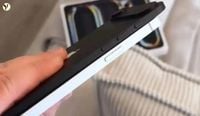The tech world is buzzing with anticipation for Apple's upcoming iPhone 17 lineup, and leaks are already painting a picture of significant changes. While the iPhone 16 is still relatively new, whispers of a revolutionary ultra-thin iPhone 17 Air, alongside significant redesigns for the Pro models and the potential iPhone 17e, are captivating consumers. This article dives into the latest leaks and rumors, exploring the potential for ultra-thin phones and comparing the anticipated iPhone 17 Air with the Galaxy S25 Edge.
The most exciting leak revolves around the rumored iPhone 17 Air, touted as Apple's thinnest iPhone yet, potentially measuring between 5mm and 6.25mm. Initial rumors suggest a 6.6-inch display, a smaller battery, and the absence of a bottom-firing speaker. However, some analysts believe this might be countered with a higher-density battery, making the sacrifice less significant. This ultra-thin design raises the question: do we need super-thin phones? While aesthetically pleasing, extreme thinness can compromise durability and ergonomics. The rumored $899 price point (subject to tariff adjustments) will be a key factor in consumer adoption.
Leaks suggest significant camera module redesigns for the iPhone 17 Pro and Pro Max. CAD renders reveal a long, horizontal camera bar – a substantial departure from previous models. This design, coupled with rumors of a switch from titanium to aluminum frames, is causing a stir. The rumored specs are plentiful, including a possible 48MP telephoto lens, 24MP front camera, and A19 Pro chip. However, inconsistencies exist, with some sources mentioning 12GB RAM and others sticking with 8GB. While the design is quite controversial, the new camera module might suggest some improved hardware on the inside to support the changes.
The iPhone 17 Air will directly compete with Samsung’s Galaxy S25 Edge. The Edge, rumored to be priced at $1099, is expected to boast a similar 6.6-inch screen and a thickness of 6.4mm. Early indications suggest a camera advantage for the iPhone 17 Air (with two lenses compared to the Edge’s single lens), although the Edge could offer a larger battery. Ultimately, a thorough comparison is required to determine which phone strikes the right balance between thinness and functionality.
The iPhone 17 Air is expected to house a single 48MP rear camera. The standard iPhone 17 is expected to feature a dual-rear camera system. Apple is reportedly preparing for a major shakeup in its iPhone lineup in 2025. The iPhone 17 Air is expected to be the thinnest iPhone ever made, with a thickness of just 5.5mm to 6.25mm. It is expected to feature a 6.6-inch OLED screen, while the standard iPhone 17 will likely come with a 6.3-inch OLED display. In terms of looks, the iPhone 17 Air is expected to have a single rear camera placed in a horizontal bar design. On the other hand, the iPhone 17 will likely keep the pill-shaped dual-camera layout, similar to what we’ve seen on the iPhone 16.
Both phones are said to feature a 24MP front camera, a big jump from the 12MP sensor. Under the hood, both devices will likely be powered by Apple’s A19 chip and might come with 8GB RAM. Apple is also reportedly working on a new anti-reflective coating for the display. Apple is expected to launch the iPhone 17 series between September 11 and 13, 2025. As far as the price is concerned, the iPhone 17 Air is expected to start at Rs 89,900. Meanwhile, the iPhone 17 could come with a starting price tag of Rs 79,900.
Leaks have already hinted at a thinner body, a fresh design, Apple's own 5G modem, and a new chip under the hood. While nothing is confirmed yet, here's what we know so far about the upcoming iPhone 17 Air. One of the most talked-about changes is the thickness of the device. The iPhone 17 Air could be Apple’s thinnest iPhone ever, reportedly measuring just 5.5mm thick. For context, this would make it slimmer than the iPhone 6, which was 6.9mm. The idea behind the slim body could be to make the phone feel lighter and more comfortable to hold, though it might come at the cost of battery size or other internal components. Even so, this new design could make the Air stand out among the rest of the iPhone 17 series.
Unlike the other models in the iPhone 17 lineup, which are expected to feature multiple cameras, the iPhone 17 Air may come with just one. Rumours suggest a 48-megapixel rear camera, possibly placed inside a wide horizontal bar at the back of the phone. This would give it a different look compared to the usual camera bumps on iPhones. While it may lack zoom features, the camera should still be good enough for everyday photography. There’s also some talk about a top-centred camera, though the final details remain unknown.
The iPhone 17 Air is likely to feature a screen between 6.6 and 6.7 inches. This puts it slightly above the regular iPhone 17 in terms of display size, but still smaller than the Pro Max model. What makes this interesting is that the bigger screen could come in a body that’s much thinner than usual. For users who want a large screen without carrying a bulky phone, this model might be a good middle ground.
Another change could be on the inside. The iPhone 17 Air is expected to use Apple’s own 5G modem instead of one from Qualcomm. This would make it the second iPhone to feature an in-house modem, after the iPhone 16e. The modem is said to offer download speeds of up to 4Gb/s, although it might not support mmWave 5G. If Apple does move forward with this, it would help the company rely less on outside suppliers.
To keep the pricing in check, Apple is expected to power the iPhone 17 Air with the standard A19 chip, while the Pro models may come with the more powerful A19 Pro version. Even though it won’t be the fastest chip Apple makes, the A19 should still offer top-tier performance for most daily tasks. This approach could allow Apple to position the Air as a more affordable alternative within the iPhone 17 range, while still offering good value.
The iPhone 17 lineup promises exciting innovations, particularly the ultra-thin iPhone 17 Air. However, the ultimate success of these models will depend on whether consumers value extreme thinness over other features like battery life and durability. The iPhone 17 Pro and Pro Max’s redesigned camera modules and rumored specs offer compelling improvements for photography enthusiasts. Ultimately, the September launch will reveal the full picture and decide whether the trend for ultra-thin smartphones will truly take off.






